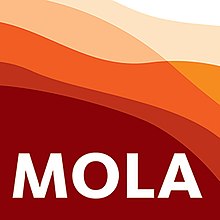
Back Museum of London Archaeology German Museum of London Archaeology French Museu de Arqueologia de Londres Portuguese
 | |
| Company type | Archaeology and built heritage practice and independent charitable organisation |
|---|---|
| Predecessor | Department of Urban Archaeology (DUA),
Department of Greater London Archaeology (DGLA), L - P : Archaeology, Museum of London Archaeology Service (MoLAS), Northamptonshire Archaeology |
| Founded | 1973 |
| Headquarters | London,
, Northampton, Basingstoke, Stansted, Bristol, ChesterUnited Kingdom |
Key people | Guy Hunt (Chief Executive) |
| Revenue | 17,694,524 pound sterling (2021) |
Number of employees | 450 (2023) |
| Website | www |
MOLA (Museum of London Archaeology) is an archaeology and built heritage practice and independent charitable company registered with the Chartered Institute for Archaeologists (CIfA), providing a wide range of professional archaeological services to clients in London and across the country. It is one of the largest archaeological service providers in the UK, and is the only one with IRO (Independent Research Organisation) status.[1]
MOLA’s operations were historically focused within Greater London but are increasingly nationwide. It employs over 300 staff across 4 locations: the central London headquarters, and further offices in Northampton, Basingstoke, and Birmingham.
MOLA is a registered charity (since 2011[2]) with its own academic research strategy and extensive community engagement and education programmes including the Thames Discovery Programme, CITiZAN[3] and the Time Truck.[4]
Commercial services offered include expertise and advice at all stages of development from pre-planning onwards: management and consultancy advice, impact assessments, excavation, mitigation (urban, rural, infrastructure, and other schemes), standing building recording, surveying and geomatics, geoarchaeology, finds and environmental services, post-excavation and publication, graphics and photography, editing, and archiving.[5]
Since 2017 MOLA has been part of a consortium with Headland Archaeology – MOLA Headland Infrastructure – to enable the delivery of archaeological and heritage services to large-scale infrastructure projects.[6]
- ^ "Independent Research Organisation status for MOLA – Arts and Humanities Research Council". ahrc.ukri.org. Retrieved 2 July 2018.
- ^ "Charity Details". beta.charitycommission.gov.uk. Retrieved 2 July 2018.
- ^ "CITiZAN – Coastal and Intertidal Zone Archaeological Network". www.citizan.org.uk. Retrieved 16 August 2018.
- ^ "Time Truck". MOLA. Retrieved 16 August 2018.
- ^ "MOLA (Museum of London Archaeology) | The Institute for Archaeologists". www.archaeologists.net. Archived from the original on 20 August 2018. Retrieved 6 August 2018.
- ^ "MOLA and Headland Archaeology form major new infrastructure consortium – MOLA Headland Infrastructure". MOLA Headland Infrastructure. 19 December 2016. Retrieved 6 August 2018.
© MMXXIII Rich X Search. We shall prevail. All rights reserved. Rich X Search